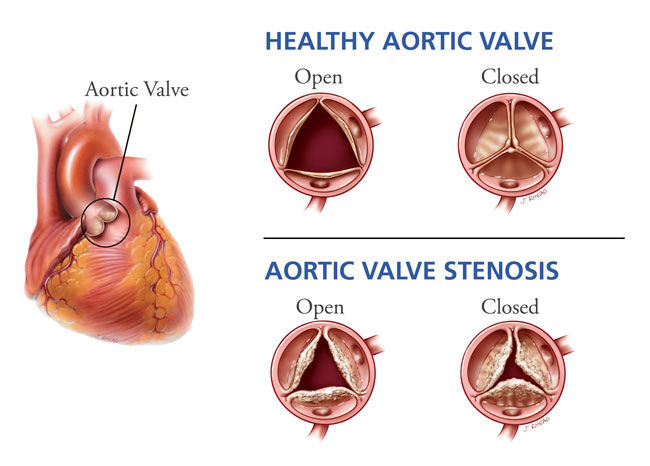Aortic Stenosis Prognosis: What 6 Facts Should You Know?
Written By: Adam Pick, Patient Advocate, Author & Website Founder
Page Last Updated: May 10, 2025
You may have been diagnosed with aortic stenosis – a relatively common, but serious form of heart disease. Or, you might know someone who has a stenotic aortic valve. If so, you’ll want to know the likely course of this potentially life-threatening condition.
Here are 6 important facts about the prognosis of aortic stenosis to help educate and empower you.

1. As Our Population Ages, Aortic Stenosis Is Becoming More Prevalent
The American Heart Association describes aortic stenosis as a narrowing of the opening of the aortic valve that restricts blood flow from the left ventricle to the aorta. If left untreated, the aortic stenosis prognosis for a patient will eventually mean damage to the heart itself.
According to the Journal of the American College of Cardiology, the population at risk for aortic stenosis is growing. It is estimated that 2.5 million people in the U.S. over the age of 75 suffer from aortic stenosis, which is about 12% of that population.
As our population ages, the U.S. Census Bureau estimates that by the year 2030, 33 million Americans will be 75 older. So given that same proportion of 12%, it would mean 4 million people would be most at-risk to develop aortic stenosis. Not a small number!
According to the British Medical Journal, aortic stenosis is also more likely to affect men than women as 80% of adults with aortic stenosis are male.
2. People Who Have Aortic Stenosis Don’t Always Have Symptoms
Aortic stenosis is often misdiagnosed and often under-treated. Symptoms are regularly and incorrectly attributed to the normal aging process, and those suffering from aortic stenosis can be symptom-free. According to Edwards Lifesciences, people may even live with aortic stenosis for years before symptoms appear.
The American Heart Association notes that many people with aortic stenosis do not experience noticeable symptoms until blood flow becomes significantly restricted. When people do experience symptoms of aortic stenosis, they can include:
- Shortness of breath
- Dizziness or fainting
- Fatigue or reduced ability to do activities requiring mild exertion
- Chest pain, pressure or tightness
- Palpitations or a feeling of heavy, pounding, or noticeable heartbeats
It’s important for you to speak up if you notice a decline in routine physical activities by a loved one. It’s worth a visit to the doctor.
3. Severe Aortic Stenosis is Life-Threatening and Must Be Treated
If left untreated, the prognosis for aortic stenosis patients can be serious and potentially fatal. As the heart labors to pump blood through a narrowing opening, aortic stenosis can progress and cause increasing problems to your heart.
According to the American Heart Association, the wall of the left ventricle may thicken as muscles around it build up because the ventricle is forced to work harder to pump blood through the constricted valve opening into your aorta.
As a result, the thickened wall takes up more space inside the lower heart chamber which allows less room for enough blood to be supplied to the body, which may cause heart failure.
According to the British Medical Journal, after symptoms appear, patients with severe aortic stenosis have a survival rate as low as 50% at 2 years – and 20% at 5 years – without aortic valve replacement. So timely treatment is critical if you exhibit symptoms.
To learn more, please read, "The Aortic Stenosis 'Danger Zone' is Here!".
4. Aortic Stenosis Is Often Treated With Valve Replacement
Treatment for aortic stenosis depends on the severity of your condition, whether you're experiencing symptoms, and if your condition is worsening.
According to the Mayo Clinic, your doctor may recommend healthy lifestyle changes and medications to treat symptoms or reduce the risk of complications.
If your aortic stenosis has gotten worse and your aortic valve needs to be replaced, there are various treatment options now available for severe aortic stenosis.
According to the Mayo Clinic, doctors rarely repair an aortic valve to treat aortic valve stenosis, and generally aortic valve stenosis requires aortic valve replacement.
In aortic valve replacement, your surgeon removes the damaged valve and replaces it with a mechanical valve or a valve made from cow, pig or human heart tissue (biological tissue valve).
In addition to conventional aortic valve open-heart replacement surgery, you may be a candidate for transcatheter aortic valve replacement (TAVR). In TAVR, doctors insert a catheter in your leg and guide it to your heart. A replacement valve is then inserted through the catheter and guided to your heart.
Here's the inspirational patient success story of Jean Frank, a member of our community, who had a TAVR performed during the recent low-risk clinical trial.
5. Many Notable People Surgery To Treat Their Aortic Stenosis
Despite the critical nature of aortic stenosis – don’t worry – you’re not alone. Last month, you may have heard about Mick Jagger’s diagnosis and surgery. We’ve learned that he’s recovering well.
Included in the millions of Americans who have had aortic stenosis are dozens of other celebrities from many industries such as:
- From Hollywood: actor and former governor, Arnold Schwarzenegger, Academy Award-winning actor, Robin Williams and the late comedian and actor, Rodney Dangerfield.
- From the sports world, the former coach of the Denver Broncos, John Fox, current manager of the New York Yankees, Aaron Boone and baseball personality, Bob Uecker.
- And also: Financial executive Charles Schwab, journalists and former television hosts, Jim Lehrer and Barbara Walters. Former First Lady Barbara Bush and fitness guru, Jack Lalanne, who both lived past the age of 90 after their heart valve surgeries.
6. There Are Ways to Help Slow Down Aortic Stenosis Progression
While not entirely preventable (Hey, even Jack Lalanne needed valve replacement!), the American Heart Association describes some heart-healthy lifestyle habits to incorporate into your life. These include:
- EAT a heart-healthy diet. Eat fruits and vegetables, low-fat dairy products, poultry, fish, and whole grains. Avoid saturated and “trans” fat, and excess salt and sugar.
- MAINTAIN a healthy weight.
- GET regular physical activity. Include 30 minutes of physical activity, such as brisk walks, into your daily fitness routine.
- MANAGE stress. Do so through relaxation activities, meditation, physical activity, and spending time with family and friends.
- AVOID tobacco. If you smoke, quit.
- TALK to your doctor before you become pregnant.
I hope you found these 6 facts about the prognosis for patients with aortic stenosis useful! So you know, I was first diagnosed with mild aortic stenosis when I was 24. By the time I was 33, the disease became severe and I started to become symptomatic as my left ventricle enlarged. I decided to have an aortic valve replacement surgery using the Ross Procedure. Nearly 20 years later, I'm doing great! My thoughts and prayers are with you or your loved one.
Keep Learning!
Here is more information to help educate and empower you about aortic stenosis:
- Aortic Stenosis Progression: Top 5 Facts to Know
- Breaking News: Low-Risk TAVR Trial Results Celebrated
- Echocardiogram Criteria for Aortic Stenosis Patients
- Mick Jagger's Heart Valve Surgery: What Should You Know?
REFERENCES:
American Heart Association: https://www.heart.org/en/health-topics/heart-valve-problems-and-disease/heart-valve-problems-and-causes/problem-aortic-valve-stenosis
Mayo Clinic: https://www.mayoclinic.org/diseases-conditions/aortic-stenosis/diagnosis-treatment/drc-20353145
Edwards Lifesciences: https://newheartvalve.com/hcp/about-aortic-stenosis/ U.S. Census Bureau: https://factfinder.census.gov/faces/tableservices/jsf/pages/productview.xhtml?src=bkmk
Journal of the American College of Cardiology: https://www.ncbi.nlm.nih.gov/pubmed/23727214 U.S. Census Bureau: https://www.census.gov/prod/2010pubs/p25-1138.pdf The British Medical Journal: https://www.bmj.com/content/336/7643/550/rapid-responses Heart Valve Surgery: https://www.heart-valve-surgery.com/tavr-procedure.php/ YouTube: https://www.youtube.com/watch?v=CHv2w8ZFaQg



